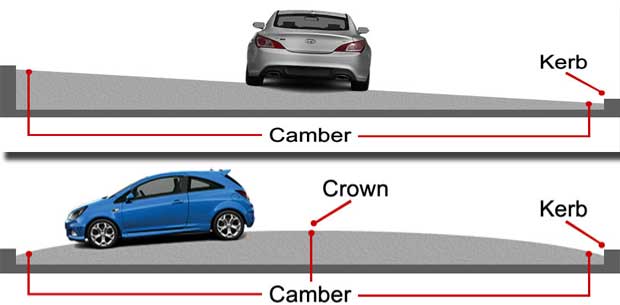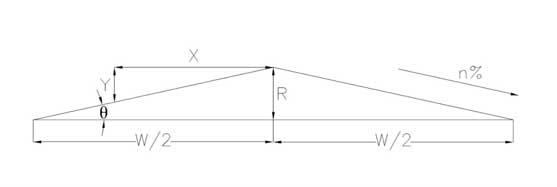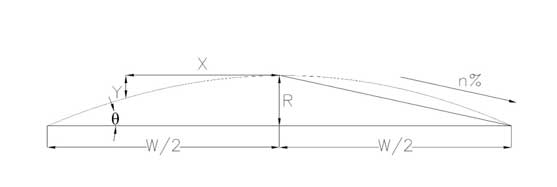
We have seen almost all highways being raised in the middle portion of the road surface with respect to the edges. This cross slope in the transverse direction is called as the Camber (or Cant). It is generally provided with the sole purpose of draining the rain water from the road surface towards the edges.
Other objectives of providing camber are:
- Protection of the road surface, especially for gravel and bituminous roads by draining the unwanted water as quickly as possible.
- Protection of the subgrade by providing good drainage conditions.
- For safety considerations, as wet pavement conditions are quite undesirable from safe driving point of view.
The cross-section shape of the transverse or cross slope can be curved, straight or a combination of both. The central part of the road which is raised is called the crown.
The cross slopes can be expressed in slope as 1 in n or in percentages as n% (for example, 1 in 50 or 2%). The design values of cambers mainly depend upon the type of the pavement and also on the average amount of the rainfall in the area. Steep cambers are effective in quick removal of surface water but are undesirable as they will erode the surface. Generally, cambers of slope 2 to 3% are provided. On straight sections of roads, shoulders are provided with higher cross fall than that of the carriageway by 0.5%.
| Values of cambers depending upon the type of pavement | ||||
| Pavement type | Cement concrete | Bituminous | Gravelled | Earthen |
| Camber, % | 1.5 to 2% | 2 to 3 % | 4% | 5% |
Excessive camber should not be provided unnecessarily because of the following reasons:
- Due to steep cross slope, most of the vehicles will have the tendency to move along the centre line of the road, thus affecting the road capacity.
- Major accidents can be caused due to instability of highly loaded vehicles.
- The edges will wear out faster than the central part.
- Cross rots are formed.
Types of camber
There are generally three types of cambers provided along the road surface, namely straight line, parabolic and composite cambers.
Straight line camber
These are provided with two equal uniform straight line slopes at both sides of the crown and are also known as Plane cross slopes. They are generally adopted for very flat slopes such as PCC or RCC Pavement.

If w is the width of the pavement, n is the camber and R is the difference of level between edge and crown,
![]()
![]()
Also, ![]()
or, ![]()
Hence, ![]()
Parabolic Camber
In parabolic camber, the cross slope is in the shape of simple quadratic parabola. In this case, the ordinate Y varies as the square of abscissa X (simple parabola equation).

![]()
![]()
∴![]()
![]()
∴![]()
Parabolic cambers are designed for fast moving highways. A favourable condition for overtaking operation is provided due to the curved cross slope. As the slope increases outward to the road edge, the flow of surface water away from the pavement is enhanced. One disadvantage of parabolic cambers is that they are very difficult to construct.
Composite camber
Composite camber may be composed of partly parabola and partly straight line or two straight lines having different slopes. Generally central part of the road is made parabolic and provided with straight slopes near edges. This helps to decrease in intensity of pressure by increasing the contact area of the wheel.
